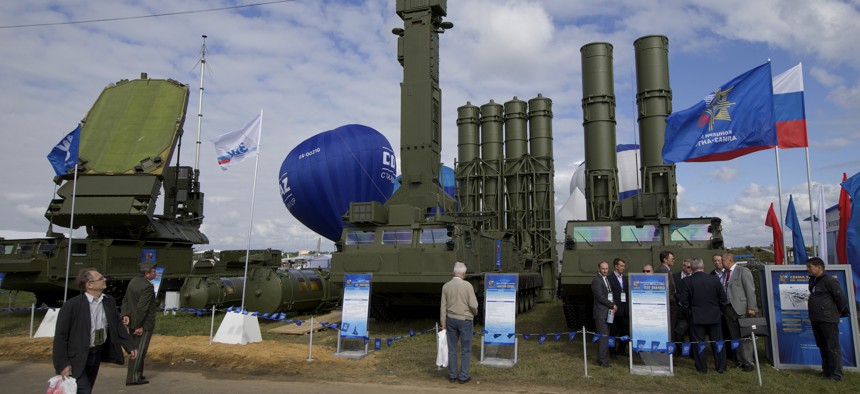
Russian air defense system missile system Antey 2500, or S-300 VM, is on display at the opening of the MAKS Air Show in Zhukovsky outside Moscow on Tuesday, Aug. 27, 2013. Ivan Sekretarev/AP
As Russia Improves Its Surface-to-Air Missiles, US Looks To Counter
The U.S. Air Force chief hopes cyber tactics can defeat a new generation of anti-air defenses.
In a dimly lit conference room at the Abu Dhabi National Exhibition Centre, Russian defense executives showed images of U.S. aircraft and the high-tech missiles they said could shoot them down.
A balding, middle-aged man in a dark suit showed briefing slides that described sophisticated surface-to-air missile batteries with impressive specifications. One slide listed potential targets, including the ultra-stealthy U.S. Air Force F-22 Raptor.
Speaking in English with a thick Russian accent, the presenter ticked off other things the system could destroy: ballistic missiles, early warning aircraft, tactical fighters, and bombers.
“Including stealthy ones,” he said with emphasis, one of the only points of inflection in his rather monotone presentation.
It’s the latest move in a decades-old chess game between ever-stealthier U.S. aircraft and increasingly lethal anti-aircraft defenses developed by companies like Russia’s Almaz-Antey. But the Pentagon believes it has a potent new weapon against networked surface-to-air missile systems: cyber weapons to counter or spoof them.

A briefing slide presented by Almaz-Antey shows what appears to be a U.S. Air Force B-1 bomber being shot down by the Antey-2500 surface-to-air missile system. (Marcus Weisgerber/Defense One)
“How do we provide blunt force trauma from an air component perspective in the cyber domain?” Gen. Mark Welsh, the U.S. Air Force chief of staff, said at a Defense Writers Group breakfast on Wednesday. “What does that mean?
Welsh provided some possibilities: It could mean making the enemy’s air defense system go completely blank on the first minute of the conflict. Or making a surface-to-air missile radar see a thousand false targets while an aircraft sneaks through in plain sight. Or preventing a missile from launching. Or directing it to turn around and strike its own launch site.
Sign up here to watch Air Force Chief of Staff Gen. Mark Welsh sit down with Defense One's Marcus Weisgerber for an exclusive interview on April 22.
The need to create such counter-weapons is growing, say Pentagon officials. The proliferation of surface-to-air missiles and long-range tactical missiles reduces the area where U.S. forces can operate with impunity. They also say Russia and China are narrowing the U.S. military’s long-held technological edge.

A briefing slide presented by Almaz-Antey shows a U.S. Air Force B-1 bomber and F-22 fighter as targets for the Buk surface-to-air missile system. (Marcus Weisgerber/Defense One)
“We are seeing levels of weapons development in other states that we have not seen since the mid-’80s, when we faced a near-peer military competitor in the Soviet Union,” Deputy Defense Secretary Robert Work said at a March 17 conference sponsored by McAleese & Associates and Credit Suisse. “In contrast, we have potential competitors all across the spectrum developing capabilities that challenge us in all domains.”
Pentagon leaders have put in place a number of initiatives to spur more technological development by U.S. firms. Work said the Pentagon’s 2016 budget begins to “aggressively re-address some long-term modernization to stay ahead of our competitors and potential adversaries.”

A briefing slide presented by Almaz-Antey shows mobile vehicles that make up the Antey-2500 surface-to-air missile system. (Marcus Weisgerber/Defense One)
In the dark room at the IDEX International Defence Exposition and Conference in Abu Dhabi in February, the executives from Almaz-Antey touted two such systems. One was the Buk, the surface-to-air missile suspected of shooting down Malaysia Airlines Flight 17 over Ukraine last year. The other was the Antey-2500, a long-range air and missile defense system. “This system is very efficient for protection of [sensitive] administrative, industrial and military facilities, troop formations, coastal infrastructure and navy bases,” the Russian presenter said.
Both systems are for sale on the international market. The Antey-2500 has been bought by Venezuela and has reportedly been purchased by Egypt and offered to Iran.
NEXT STORY: 'Iraq Is Finished'





